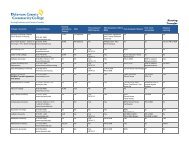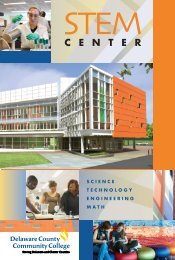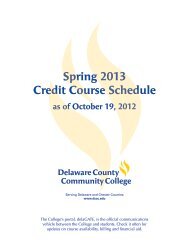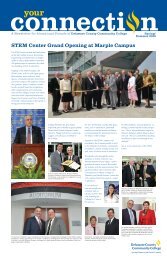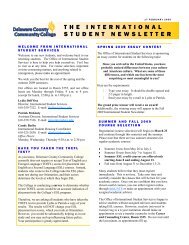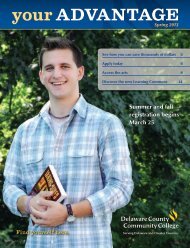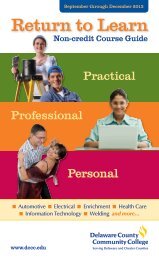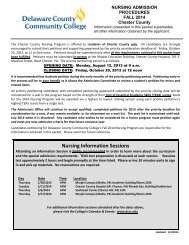2010 Catalog - Delaware County Community College
2010 Catalog - Delaware County Community College
2010 Catalog - Delaware County Community College
Create successful ePaper yourself
Turn your PDF publications into a flip-book with our unique Google optimized e-Paper software.
88 COURSE DESCRIPTIONS<br />
ART 235 Digital (SLR) Photography III<br />
Special Studies<br />
This is an all black and white lab intensive course for<br />
students with two semesters of previous coursework in<br />
digital photography. The use of photography as an<br />
expressive tool is approached by study and application of<br />
advanced methods of working with their digital SLR<br />
camera to edit images combining Adobe Lightroom 2 and<br />
Adobe Photoshop to produce images in black-and-white.<br />
Students will learn about the art of applying filters and<br />
curves to emulate various toning processes that were done<br />
using photo chemicals in a traditional darkroom. Students<br />
will learn to select printing papers to enhance image<br />
quality. The limits of the fine print will be explored.<br />
Upon successful completion of this course, students<br />
should be able to:<br />
• Pre-visualize subject matter for black-and-white imaging.<br />
• Adjust exposure to compensate for seeing brightness<br />
with an emphasis for the medium of black-and-white<br />
photography.<br />
• Controls the tonal range in prints from digital files made<br />
under a variety of lighting conditions.<br />
• Understand and apply the use of different type’s inkjet<br />
papers in combination with various inkjet printers.<br />
• Understand how to combine the use of Adobe Lightroom<br />
2 and Adobe Photoshop for editing.<br />
• Apply filters and curves for the counting process.<br />
• Understand the use of printing profiles for various<br />
inkjet papers.<br />
• Prepare a portfolio of exhibition quality, archive really<br />
matted prints.<br />
3 Credits 2 Weekly Lecture Hours<br />
2 Weekly Laboratory Hours<br />
(AUT) Auto Mechanics<br />
AUT 100 Introduction to Automotive<br />
Service Operation and Shop Practices<br />
This introductory course is designed to provide the student<br />
with knowledge and skill in automotive service operations<br />
and shop practices. The student will interact with various<br />
automotive service organizations, dealerships, and independent<br />
service and repair contractors. Proper handling,<br />
parts departments, job classifications, training for a career<br />
in the automotive service and repair industry, and other<br />
automotive business related topics will be addressed. This<br />
course presents instruction in automotive terminology, use<br />
of service manuals, diagnostic equipment, use of shop<br />
tools, hand tools, and power tools in relation to shop<br />
practices and safety. Accident prevention practices, first aid<br />
tools and equipment, and personal environmental safety<br />
practices and procedures will be stressed throughout the<br />
course. In addition, an overview of the automotive engines<br />
system, its major components, delivery units, preventive<br />
maintenance, and basic mathematics will be covered.<br />
Upon successful completion of this course, students<br />
should be able to:<br />
• Demonstrate personal and environmental safety practices.<br />
• Apply basic first aid procedures. Identify tool and<br />
equipment nomenclature.<br />
• Apply and utilize tool safety regulations.<br />
• Explain Occupational Safety and Health Act (OSHA).<br />
• Utilize service manuals/electronic media.<br />
• Identify all data informational systems.<br />
• Perform basic mathematical calculations.<br />
• Identify the major components of the automobile.<br />
• Perform calculations using the metric system.<br />
2 Credits 1 Weekly Lecture Hours<br />
2 Weekly Laboratory Hours<br />
AUT 101<br />
Automotive Electricity and<br />
Electronics<br />
This course is designed to prepare the student to work in<br />
the field of electricity and electronics as it relates to the<br />
modern day automobile. The course covers concepts in basic<br />
electricity, electrical terms, electrical circuits, and electronic<br />
systems protection. The student will be introduced to various<br />
types of batteries such as deep cycle batteries and hybrid<br />
batteries, their design, maintenance, size, selection, factors<br />
affecting the battery's life, safety procedures, testing,<br />
charging, and jump-starting. Emphasis will be placed on<br />
the ignition system, its design, components, control circuits,<br />
testing, disassembly and assembly. The course is also<br />
designed to provide the student with a basic understanding<br />
of present and future developments in sophisticated<br />
automotive electronics. In addition, indicator systems,<br />
pollution control systems and other modern automotive<br />
accessory systems will be addressed.<br />
Upon successful completion of this course, students<br />
should be able to:<br />
• Perform electronic pollution controls testing, service and<br />
repair requirements. Identify basic electronic circuits used<br />
in the modern automobile.<br />
• Identify system defects and troubleshooting procedures.<br />
• Utilize various techniques to adjust electronic<br />
ignition systems.<br />
• Recognize electronic braking systems.<br />
• Test, service, and repair various systems according<br />
to requirements.<br />
• Identify indicators and gauges.<br />
• Repair power operated cruise control. Install warning,<br />
security, and sound systems.<br />
• Identify electronic controlled trip computers, and<br />
digital indicator systems. Troubleshoot warning, and<br />
warning indicators.<br />
Prereq. AUT 100<br />
4 Credits 2 Weekly Lecture Hours<br />
4 Weekly Laboratory Hours<br />
AUT 102<br />
Automotive Engines<br />
This course is designed to provide the student with the<br />
fundamental theory, construction, inspection, measurement,<br />
performance, and identification of the automobile's engine.<br />
Integrating theory and practical application in the lab is<br />
stressed throughout the course. The course covers topics<br />
such as preparing the engine for removal, lifting,<br />
disassembly, assembly, and inspection, as well as<br />
identifying, diagnosing, and evaluating engine parts. The<br />
student will gain skill in analyzing defects and the proper<br />
process to administer specific maintenance requirements. In<br />
addition, the student will be exposed to concepts in cylinder<br />
block reconditioning, crankshaft inspection and measurements,<br />
piston rings inspection, renewal, and installation.<br />
Upon successful completion of this course, students<br />
should be able to:<br />
• Prepare engines for removal.<br />
• Disassemble, inspect, and clean engine parts. Install<br />
bearing, pistons, piston rings, and crankshaft.<br />
• Assemble the cylinder head.<br />
• Remove the camshaft.<br />
• Install timing components, gears chain, and belts.<br />
• Inspect and service oil pumps.<br />
• Inspect aluminum cylinder heads; combustion chamber,<br />
and intake exhaust valves.<br />
• Follow valves reconditioning guide for valve seats, and<br />
valve stem seals.<br />
• Adjust hydraulic and manual valve clearance.<br />
• Lubricate and test cooling system.<br />
• Inspect air induction system and exhaust<br />
system components.<br />
• Service turbochargers and superchargers.<br />
• Utilize torque wrench and its components.<br />
• Thread and repair gaskets and their sealing properties.<br />
• Use adhesives, sealant and other sealing materials.<br />
• Reassemble engine and install engine in the vehicle.<br />
• Perform crankshaft inspection measurements.<br />
Prereq. AUT 100<br />
4 Credits 2 Weekly Lecture Hours<br />
4 Weekly Laboratory Hours<br />
AUT 103<br />
Brake Systems<br />
This course is designed to introduce students to the<br />
principles of hydraulic brake systems and their components.<br />
The course will emphasize how to analyze and repair<br />
domestic and foreign brake systems to include shoe, disc,<br />
hydraulic, vacuum and air brake systems. Instruction will<br />
include principles of hydraulic brake systems, its components,<br />
hydraulic system safety switches and valves, master cylinder<br />
operation, as well as inspection, machining, fitting, and<br />
adjustments of brake systems. Measurements required for<br />
brakes, rotors, brake lining, and brake-bleeding procedures<br />
will be addressed. Mathematical calculation requirements<br />
and the use of digital readout units will be covered. In<br />
addition, diagnostic testing of disc brake components and<br />
functions, two and four wheel equipped disc brakes, general<br />
caliper inspection and service, rotor inspection and service,<br />
various antilock brake systems, ABS components and<br />
systems, automatic traction control and stability will be<br />
thoroughly presented.<br />
Upon successful completion of this course, students<br />
should be able to:<br />
• Identify hydraulic brake systems.<br />
• Repair brake components and systems.<br />
• Perform inspection, measurement and<br />
machining procedures.<br />
• Diagnose, service and repair antilock brake systems<br />
and automated traction control.<br />
• Service and repair four-wheel disc brake systems.<br />
• Identify principles of hydraulic brake systems and<br />
components.<br />
• Identify drum and disc brake assemblies.<br />
• Diagnose and service brake drum and rotor components.<br />
• Perform rotor inspection service and measurements.<br />
• Diagnose and repair antilock brake systems for two<br />
wheel and four-wheel units.<br />
Prereq. AUT 100<br />
4 Credits 2 Weekly Lecture Hours<br />
4 Weekly Laboratory Hours<br />
AUT 114<br />
Steering and Suspension<br />
This course is designed as an introduction to tire<br />
descriptions, wheels, tire repairs, measurements, wheel<br />
run out, tires and wheels service, and wheel bearings. The<br />
course provides the student with methods of analyzing<br />
defects and the necessary preventive or corrective<br />
maintenance requirements. Tire wear patterns and<br />
remedies will be thoroughly covered. Emphasis will be<br />
placed on McPherson Strut Systems, independent suspension<br />
systems, general front suspension inspection, and repairs.<br />
Topics such as electronically controlled suspension, manual<br />
steering systems, power steering systems, electrically<br />
controlled power steering systems, and steering system<br />
diagnosis will be covered. Visual inspection, four-wheel<br />
steering systems, alignment geometry, pre-alignment<br />
inspection, wheel alignment equipment, and alignment<br />
machines will also be presented.<br />
Upon successful completion of this course, students<br />
should be able to:<br />
• Identify tire descriptions and usage.<br />
• Perform service on tires and wheels, wheel bearings,<br />
front and rear from tapered to roller.<br />
• Identify tire wear patterns and remedies.<br />
• Repair frames, suspension system components, and<br />
McPherson Strut Systems.<br />
DELAWARE COUNTY COMMUNITY COLLEGE




